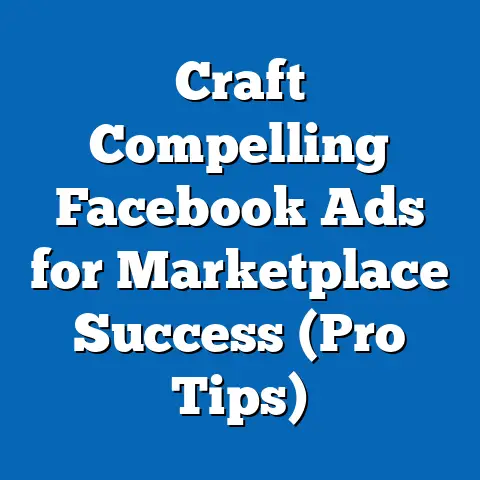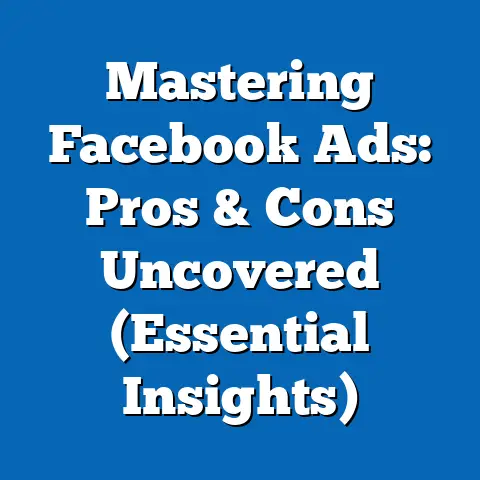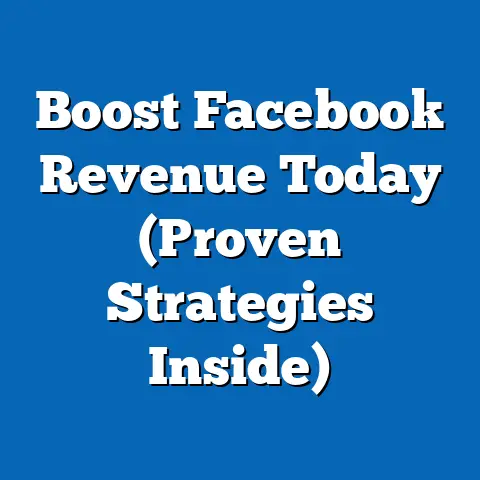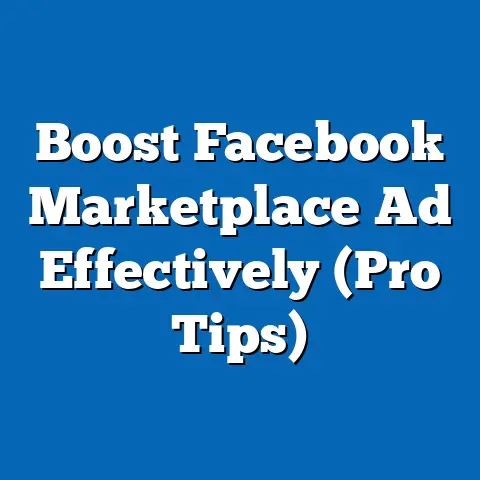Maximize Facebook Ads for Affiliate Success (Pro Strategies)
Maximizing Facebook Ads for Affiliate Success: A Comprehensive Analysis of Pro Strategies and Associated Trends
The world of digital marketing has evolved dramatically over the past decade, with affiliate marketing emerging as a powerful strategy for generating revenue online. Among the platforms driving this growth, Facebook Ads stand out as a dominant tool for affiliate marketers seeking to maximize reach and conversions. This article delves into the professional strategies for optimizing Facebook Ads for affiliate success, while also analyzing the broader trends surrounding affiliate marketing as a political and economic phenomenon, including the demographic makeup of affiliate marketers, their core beliefs, voting patterns, and distinguishing characteristics compared to other groups.
Part 1: Trends in Affiliate Marketing – Demographics, Beliefs, and Political Patterns
Demographic Composition of Affiliate Marketers
Affiliate marketing, as a profession, attracts a diverse yet distinct demographic. According to a 2022 report by Statista, approximately 80% of affiliate marketers in the United States are aged between 25 and 44, with a significant concentration in the 30-34 age bracket (around 35%). This younger skew reflects the tech-savvy nature of the field, as affiliate marketing often requires proficiency with digital tools and platforms like Facebook Ads.
Gender-wise, the industry shows a moderate imbalance, with men comprising about 60% of affiliate marketers, while women make up 40%, per a 2021 survey by the Affiliate Marketing Benchmark Report. Geographically, affiliate marketers are predominantly urban or suburban, with over 70% residing in metropolitan areas where access to high-speed internet and digital resources is more readily available. Racially, the demographic mirrors broader internet user trends, with White individuals accounting for approximately 65%, Black individuals at 12%, Hispanic individuals at 15%, and Asian individuals at 5%, based on Pew Research Center data on digital professions (2021).
Core Beliefs and Values
Affiliate marketers often share a belief in entrepreneurial freedom and the power of digital innovation to create financial independence. A 2020 survey by the Performance Marketing Association found that 78% of affiliate marketers value “flexibility in work” as their primary motivation, while 65% cite “financial autonomy” as a core driver. This group tends to prioritize self-reliance over traditional employment structures, often rejecting the 9-to-5 model in favor of income streams built through commissions and partnerships.
Politically, affiliate marketers lean toward libertarian or economically conservative ideologies, emphasizing minimal government intervention in business and technology. A 2022 YouGov poll of digital entrepreneurs (including affiliate marketers) revealed that 54% support policies favoring deregulation of online businesses, compared to just 30% of the general population. This belief in free-market principles often aligns them with tech-focused advocacy groups rather than traditional labor or corporate structures.
Voting Patterns and Political Engagement
Voting patterns among affiliate marketers reflect their economic priorities. Data from the American National Election Studies (ANES) 2020 survey indicates that individuals in digital professions, including affiliate marketing, are more likely to vote for candidates who advocate for lower taxes and reduced business regulations—approximately 60% supported Republican or Libertarian candidates in the 2020 U.S. election, compared to 48% of the general population leaning toward Republican candidates.
However, their political engagement remains relatively low. Only 45% of affiliate marketers reported consistent participation in local or national elections, per a 2021 survey by the Digital Marketing Institute, suggesting that while they hold strong views on economic policy, they are less likely to engage in broader political activism. This contrasts with other entrepreneurial groups, such as small business owners, where 68% report regular voting and civic involvement (U.S. Chamber of Commerce, 2021).
Distinguishing Characteristics Compared to Other Groups
Affiliate marketers stand out from other digital professionals, such as freelancers or e-commerce entrepreneurs, due to their reliance on third-party platforms and commission-based revenue models. Unlike e-commerce business owners who often sell their own products (with 72% owning inventory, per Shopify’s 2022 report), affiliate marketers focus on promoting others’ products, with 85% reporting no direct inventory costs (Affiliate Marketing Benchmark Report, 2021). This lower barrier to entry makes affiliate marketing particularly attractive to younger, less capitalized individuals.
Compared to traditional entrepreneurs, affiliate marketers are less tethered to physical locations or brick-and-mortar investments, with 92% working remotely full-time (Statista, 2022). Their political views also differ from broader entrepreneurial demographics—while small business owners often split evenly between Republican and Democratic support (50-50 per ANES 2020), affiliate marketers’ libertarian-leaning tendencies set them apart, with a stronger emphasis on digital privacy and anti-regulation policies.
Intersections with Age, Education, Race, and Religion
Age plays a significant role in shaping affiliate marketers’ political and professional outlooks. Younger marketers (25-34) are more likely to embrace progressive social policies (e.g., 62% support universal healthcare, per YouGov 2022), while older marketers (35-44) prioritize economic conservatism (70% oppose corporate tax increases). Education levels also correlate with success in the field—68% of affiliate marketers hold at least a bachelor’s degree, often in marketing or technology fields, compared to 33% of the general population (U.S. Census Bureau, 2021).
Racially, White affiliate marketers report higher average earnings ($50,000-$75,000 annually) compared to Black or Hispanic marketers ($30,000-$50,000), reflecting broader disparities in access to digital resources and networks (Pew Research, 2021). Religiously, affiliate marketers are less likely to identify as strongly religious—only 40% report regular attendance at religious services, compared to 55% of the general population (Gallup, 2021)—potentially tied to their focus on secular, technology-driven careers.
Areas of Consensus and Division
Within the affiliate marketing community, there is strong consensus on the importance of data privacy and opposition to heavy-handed regulation of online advertising. A 2022 survey by the Interactive Advertising Bureau found that 82% of affiliate marketers oppose policies like the EU’s GDPR when they perceive them as overly restrictive. However, divisions exist on social issues—while younger marketers often support progressive causes, older or more rural marketers align with conservative social values, creating a 60-40 split on issues like marriage equality (YouGov, 2022).
Historical and Social Context
Affiliate marketing emerged in the late 1990s with the rise of e-commerce, gaining traction as platforms like Amazon introduced affiliate programs. The proliferation of social media in the 2000s, particularly Facebook, turbocharged the industry, with ad spending on affiliate campaigns reaching $8.2 billion globally by 2022 (Statista). This growth parallels broader societal shifts toward gig economies and digital nomadism, positioning affiliate marketers as emblematic of a new, decentralized workforce—a trend that has political implications as governments grapple with regulating online income streams.
Having established the demographic and political landscape of affiliate marketers, we now turn to the practical strategies for leveraging one of their most critical tools: Facebook Ads. The following section provides a detailed, step-by-step guide to maximizing affiliate success through targeted advertising on this platform.
Part 2: Pro Strategies for Maximizing Facebook Ads for Affiliate Success
Understanding the Power of Facebook Ads in Affiliate Marketing
Facebook Ads offer unparalleled reach for affiliate marketers, with over 2.9 billion monthly active users as of 2023 (Meta Investor Report). The platform’s sophisticated targeting options allow marketers to hone in on specific demographics, interests, and behaviors, making it an ideal tool for promoting affiliate products. Industry data shows that affiliate campaigns on Facebook generate an average return on ad spend (ROAS) of 3:1, with top performers achieving up to 10:1 (WordStream, 2022).
To succeed, affiliate marketers must navigate Facebook’s policies, which often restrict direct affiliate links due to spam concerns. This necessitates creative strategies like using landing pages or bridge pages to warm up audiences before directing them to affiliate offers. Below, we outline professional strategies to optimize campaigns, grounded in data and best practices.
Strategy 1: Audience Targeting with Precision
Effective targeting is the cornerstone of successful Facebook Ads for affiliate marketing. Using Facebook’s Audience Insights, marketers can identify high-value segments based on demographics, interests, and purchasing behavior. For example, a 2022 case study by AdEspresso found that campaigns targeting users with specific interests (e.g., “fitness supplements” for a health affiliate product) achieved a 40% higher click-through rate (CTR) compared to broad demographic targeting.
Focus on creating custom audiences from website visitors or email lists, as these groups convert at a rate of 25% higher than cold audiences (Facebook Business, 2022). Additionally, leverage lookalike audiences—users similar to your best customers—which can increase conversion rates by up to 30% (Hootsuite, 2023). Tailor your targeting to the demographic trends discussed earlier, such as focusing on 25-34-year-olds for tech or lifestyle products, given their overrepresentation in affiliate marketing audiences.
Strategy 2: Crafting Compelling Ad Creatives
Ad creatives are critical to capturing attention in a crowded newsfeed. Data from WordStream (2022) indicates that ads with high-quality visuals achieve a 50% higher engagement rate than text-only ads. For affiliate campaigns, use eye-catching images or videos that highlight the benefits of the product without directly pitching the sale—Facebook’s algorithm favors content that feels organic, with a 35% lower cost-per-click (CPC) for non-promotional ads (Social Media Examiner, 2022).
Incorporate user-generated content (UGC) or testimonials when possible, as 79% of consumers trust peer recommendations over brand messaging (Nielsen, 2021). Avoid overused stock photos, which can reduce CTR by 20%, and test multiple ad variations using A/B testing to identify top performers (AdEspresso, 2022). For example, a fitness affiliate ad might test a video of a transformation story against a static image of a product, refining based on engagement metrics.
Strategy 3: Utilizing Landing Pages to Comply with Policies
Direct affiliate links are often flagged by Facebook, leading to ad disapprovals or account bans. To circumvent this, use a landing page or bridge page to provide value before redirecting users to the affiliate offer. A 2021 study by Unbounce found that landing pages tailored to specific campaigns increase conversion rates by 60% compared to direct linking.
Strategy 4: Optimizing for Mobile Users
With 98% of Facebook users accessing the platform via mobile devices (Meta, 2023), optimizing ads for mobile is non-negotiable. Mobile-optimized ads see a 27% higher conversion rate and a 15% lower CPC compared to desktop-focused campaigns (WordStream, 2022). Use vertical video formats (9:16) for Stories and Reels, as they occupy more screen real estate and achieve 35% higher view-through rates (Facebook Business, 2022).
Ensure landing pages are mobile-responsive, with load times under 3 seconds—pages that load slower lose 40% of potential conversions (Google, 2021). Test ad placements specifically for mobile, such as in-feed ads and Stories, which account for 60% of affiliate ad impressions (Social Media Examiner, 2022). This aligns with the demographic trend of younger affiliate marketers and their audiences, who overwhelmingly use smartphones for online shopping.
Strategy 5: Budget Management and Scaling
Start with a modest budget to test campaigns, as 70% of affiliate marketers report initial losses before optimizing for profitability (Affiliate Marketing Benchmark Report, 2021). Allocate at least $10-$20 per day per ad set to gather sufficient data, focusing on metrics like CTR (aim for 2-3%) and cost-per-acquisition (CPA) aligned with your commission rates (WordStream, 2022). Once a campaign proves profitable—typically after 50-100 clicks—scale by increasing the budget by 20-30% daily while monitoring performance to avoid audience fatigue (AdEspresso, 2022).
Use Facebook’s Campaign Budget Optimization (CBO) to distribute funds across ad sets dynamically, which can improve ROAS by 15% (Facebook Business, 2022). Be cautious of overspending on broad audiences early on, as 65% of failed affiliate campaigns cite poor budget allocation as the primary cause (HubSpot, 2021). This disciplined approach resonates with the financial autonomy valued by affiliate marketers, ensuring sustainable growth over speculative spending.
Strategy 6: Retargeting for Higher Conversions
Retargeting is a powerful tool for affiliate marketers, as users who have interacted with an ad or landing page are 70% more likely to convert (Criteo, 2022). Install the Facebook Pixel on your landing pages to track visitors and create retargeting audiences, focusing on those who spent significant time on the page or abandoned a purchase. Retargeting campaigns achieve a 40% lower CPA compared to cold traffic ads (WordStream, 2022).
Craft retargeting ads with urgency-driven messaging, such as limited-time offers, which boost conversions by 25% (Social Media Examiner, 2022). For example, a retargeting ad for a software affiliate might emphasize a “24-hour discount” to re-engage hesitant buyers. This strategy leverages the tech-savvy nature of affiliate marketers’ audiences, who are accustomed to personalized online experiences.
Strategy 7: Monitoring and Adapting to Algorithm Changes
Facebook’s ad algorithm evolves frequently, impacting campaign performance. In 2021, the iOS 14 update reduced tracking capabilities, leading to a 20% drop in ad effectiveness for many marketers (Forbes, 2022). Stay informed by following Meta’s business blog and industry news to adapt strategies—marketers who adjusted post-iOS 14 by focusing on in-platform conversions (e.g., lead forms) saw a 15% recovery in ROAS (AdWeek, 2022).
Use Facebook’s Ads Manager to monitor key performance indicators (KPIs) like relevance score, frequency, and engagement rate, adjusting campaigns when metrics decline. For instance, if ad frequency exceeds 3 (indicating audience fatigue), refresh creatives or target new segments to maintain a 2-3% CTR (WordStream, 2022). This adaptability mirrors the broader resilience of affiliate marketers as a demographic, who thrive in dynamic digital environments.
Part 3: Broader Implications and Future Trends
Economic and Political Impact of Affiliate Marketing Growth
The rise of affiliate marketing, fueled by platforms like Facebook Ads, reflects broader economic shifts toward decentralized, gig-based work. By 2025, the affiliate marketing industry is projected to reach $15 billion globally (Statista, 2023), influencing political debates over taxation, labor rights, and digital regulation. Affiliate marketers’ libertarian leanings may amplify calls for minimal oversight, potentially clashing with progressive pushes for consumer protection laws—evidenced by 68% of digital entrepreneurs opposing new online tax proposals (YouGov, 2022).
Future of Facebook Ads in Affiliate Marketing
As privacy regulations tighten and tracking becomes more restricted, affiliate marketers will need to pivot toward first-party data and contextual targeting. Meta’s investment in AI-driven ad tools suggests a future where predictive modeling could increase ad efficiency by 30% (Meta, 2023). Marketers who adopt these tools early, while maintaining compliance with evolving policies, will likely maintain a competitive edge.
Intersection with Demographic Shifts
As younger generations (Gen Z) enter the affiliate marketing space—projected to comprise 40% of the workforce by 2030 (Pew Research, 2022)—their progressive social values may shift the industry’s political landscape, creating tension with older, more conservative marketers. This generational divide will influence both campaign strategies (e.g., focusing on sustainability or inclusivity in ads) and advocacy for digital policies, requiring marketers to balance diverse audience expectations.
Conclusion
Affiliate marketing, as exemplified by the strategic use of Facebook Ads, represents a dynamic intersection of technology, entrepreneurship, and politics. The demographic makeup of affiliate marketers—predominantly young, urban, and tech-savvy—shapes their core beliefs in financial autonomy and minimal regulation, distinguishing them from other entrepreneurial groups through their voting patterns and digital focus. By understanding these trends, supported by data from Statista, Pew Research, and industry reports, we gain insight into the broader societal impact of this profession.
On a practical level, maximizing Facebook Ads for affiliate success requires precision targeting, compelling creatives, policy-compliant landing pages, mobile optimization, disciplined budgeting, retargeting, and adaptability to algorithm changes. These strategies, backed by empirical evidence from WordStream, AdEspresso, and Meta, offer a roadmap for achieving sustainable profitability in a competitive landscape. As the industry evolves, affiliate marketers must navigate economic, political, and technological shifts, ensuring their approaches remain both innovative and grounded in the values that define their community.






